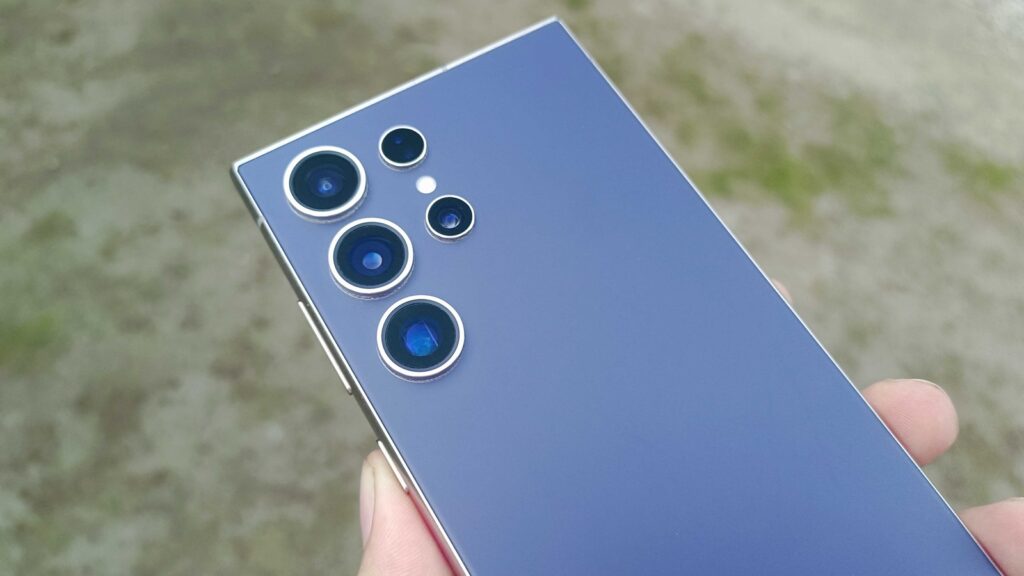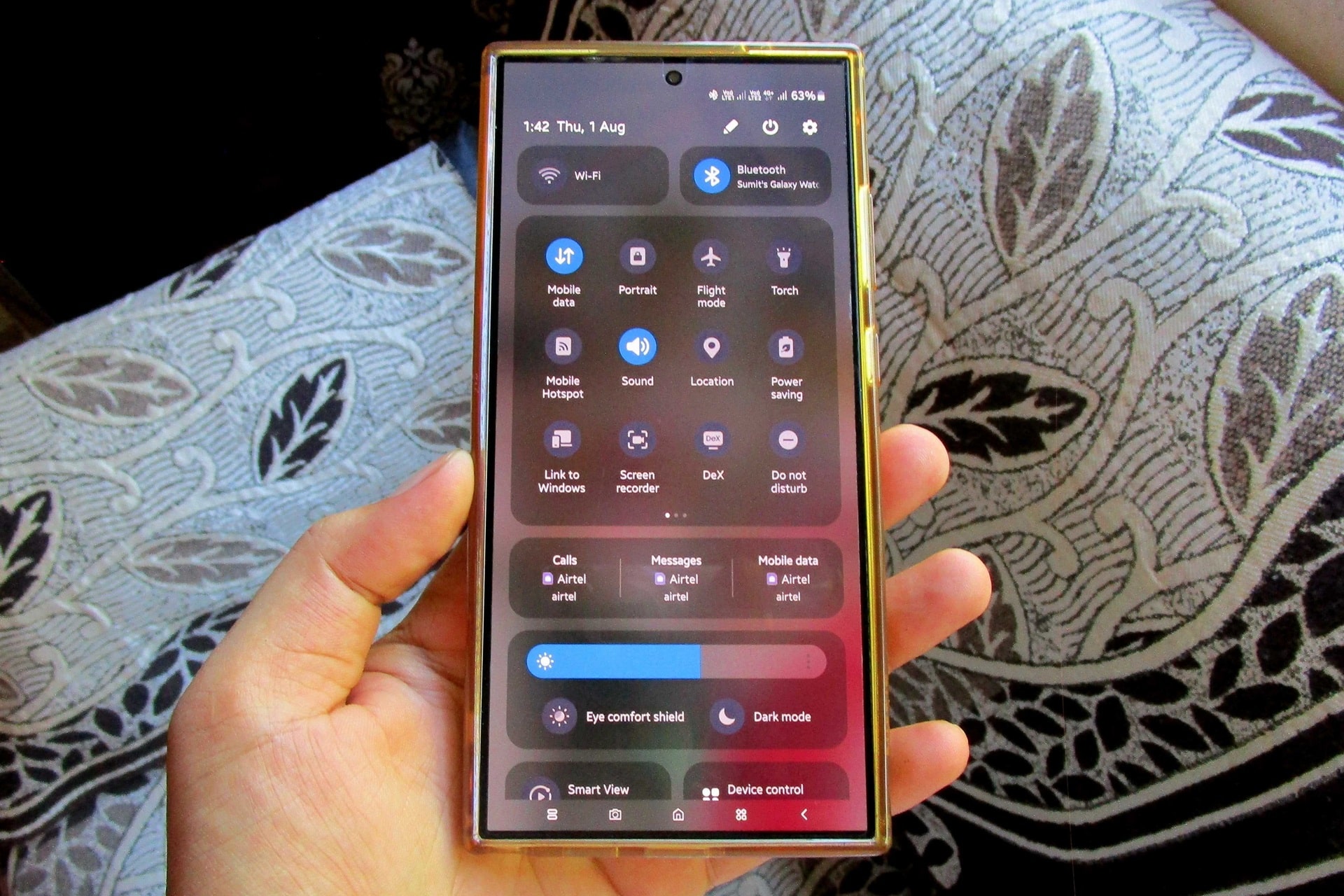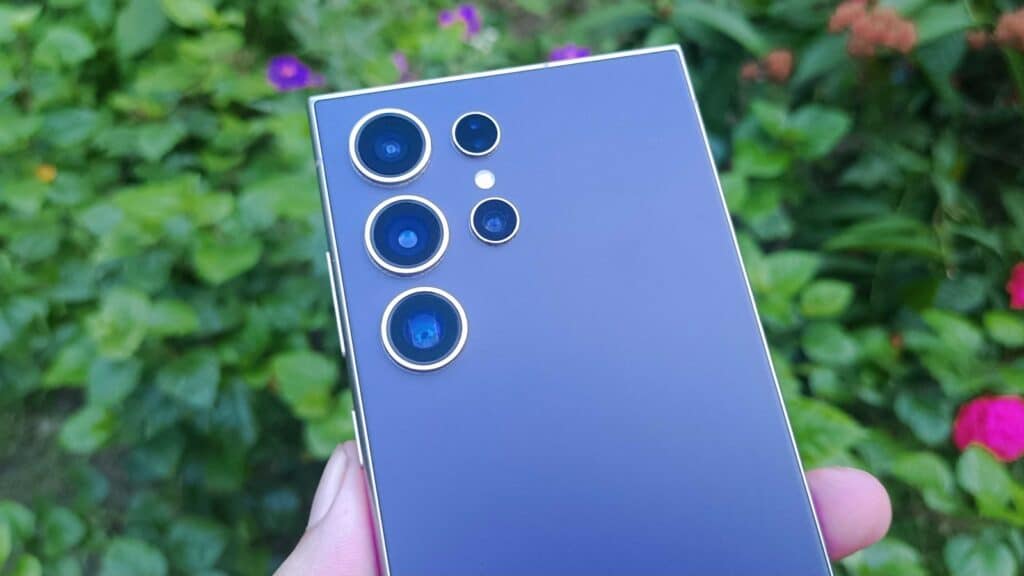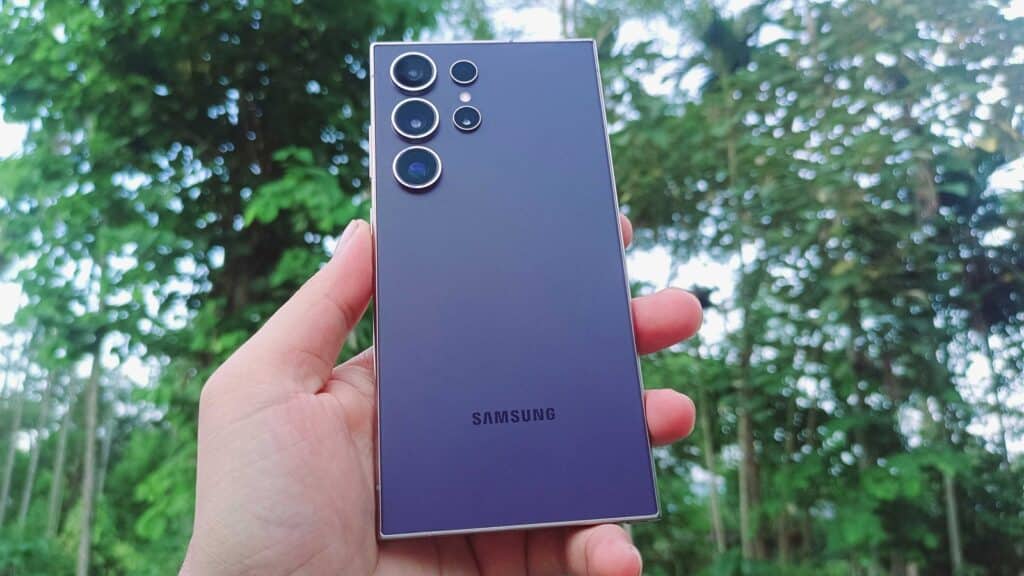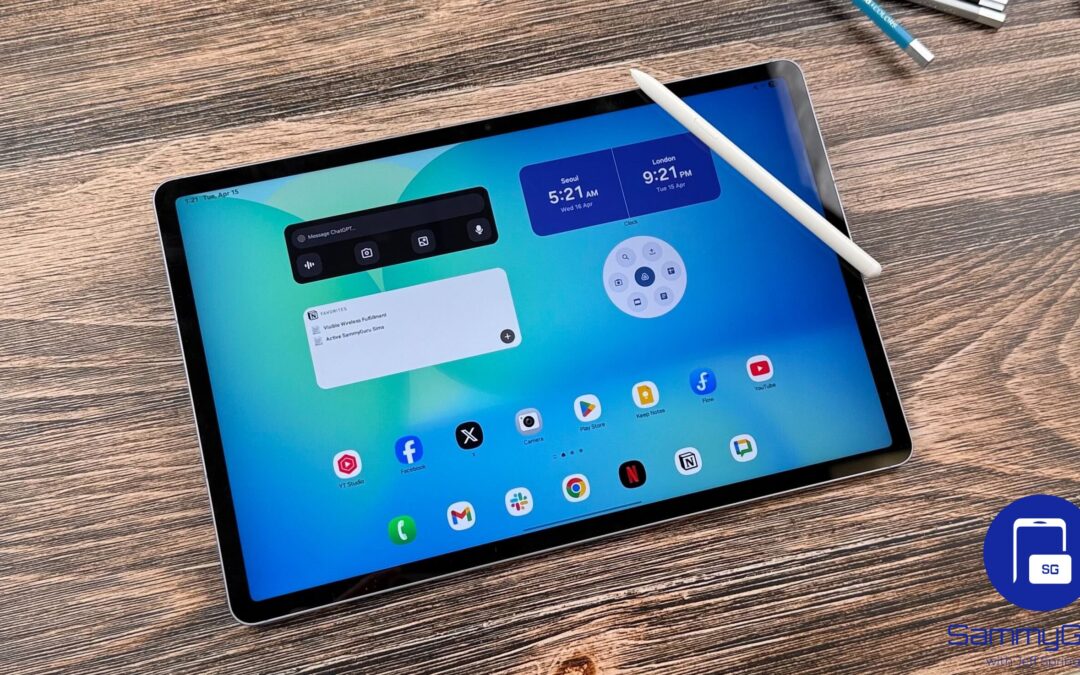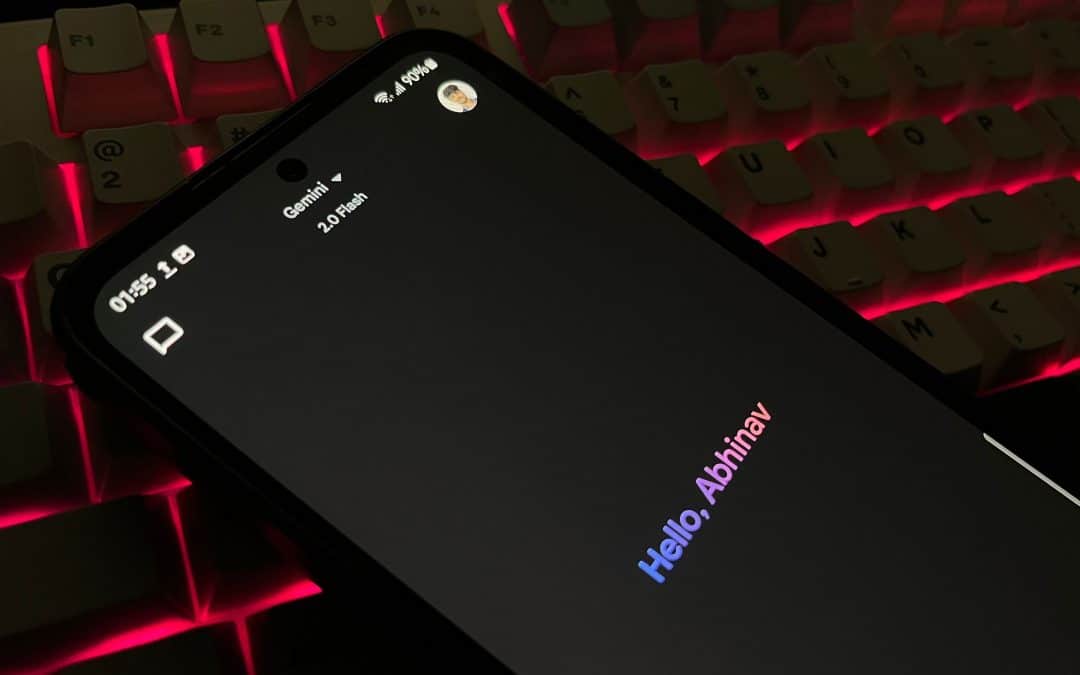Google just launched the Pixel 9 Pro XL, setting the stage for a showdown with Samsung’s Galaxy S24 Ultra. Both flagships pack cutting-edge technologies and powerful features, putting up a good fight for the title of the best Android phone. But how do they stack up against each other? In this comparison, we’ll dive into the key differences and similarities between the two, helping you decide which one deserves a spot in your pocket.
Table of contents:
Galaxy S24 Ultra vs Pixel 9 Pro XL: Design and Hardware
Google and Samsung have built a distinct identity for their phones. We can easily identify if it’s a Pixel or a Galaxy from its back. The companies refine the design language with each new generation but keep the same philosophy. The Pixel 9 Pro XL follows the same Pixel design style seen on previous models yet looks distinct. Most notably, Google has redesigned the camera strip at the back.
Earlier, the strip ran across the back panel. The Pixel 9 Pro XL has a rounded-off camera strip that doesn’t go the distance. The dual-toned strip has a pill-shaped glass covering the three cameras (detailed below), with LED flash and Laser AF (autofocus) module sitting next to it. The phone very much has a Pixel-ish look but is distinct on its own. Some people may find the camera bump too big, but it should be easy to get used to.
Samsung’s Galaxy S24 Ultra, on the other hand, has no camera bump. It has four cameras, all protruding out of the back panel individually. The overall look is mostly unchanged from the Galaxy S23 Ultra, though Samsung has made the frame flatter and switched to a flat display. These changes, coupled with its sharp corners, give the phone a boxy look. The Pixel has rounded corners and a flat display. It has a dimension of 162.8 x 76.6 x 8.5 mm and weighs 221 grams. The Galaxy measures 162.3 x 79 x 8.6 mm in dimension and weighs 233 grams.
Speaking of the frame, Google’s new flagship has an aluminum body, while Samsung switched from aluminum to titanium this year. It doesn’t appear to be the highest-quality titanium as a silicone cover can leave tiny scratch marks after a few months of continuous use, more so if you let sand particles make their way between the case and the frame. Nothing too serious but we thought you should know this. Google uses Corning’s Gorilla Glass Victus 2 on the front and back, while Samsung uses Gorilla Armor.
Catchy colors with strong protection against dust and water
The Pixel 9 Pro XL and Galaxy S24 Ultra boast an IP68 rating for dust and water resistance. The phones can survive a few drops in the pool, exposure to rain or dust storms, or accidental water spills. You don’t have to rush to protect it if caught by a sudden downpour. Both phones are built strong and can withstand a few drops too, though you shouldn’t try dropping them unnecessarily. After all, they have glass on the front and back, and glass can break easily.
Google offers the Pixel 9 Pro XL in black, white/porcelain, pink, and green/hazel colors. As usual, it uses some fancy names, but those are the four shades you can pick. The Galaxy S24 Ultra is also available in four standard colors: black, gray, violet, and yellow. Three more color options (blue, green, and orange) are exclusively available through Samsung’s official website. You have plenty of colors to choose from for both phones, with a few shades overlapping between the two.
Galaxy S24 Ultra vs Pixel 9 Pro XL: Display
Samsung makes smartphone screens for Google, Apple, and several other brands, so it’s reasonable to think that its flagship phones have the best displays in the industry. It is true but with a caveat. The Samsung-made display on the Pixel 9 Pro XL features upgraded OLED materials for improved brightness and power efficiency. It’s more of a user experience thing rather than specs. The specs are as follows.
The Galaxy S24 Ultra features a 6.8-inch Dynamic LTPO AMOLED 2X display with a 120Hz refresh rate, a QHD+ resolution (1440 x 3120 pixels), HDR10+ support, and 2600 nits of peak brightness. The Pixel 9 Pro XL’s display has similar specs. It is a 6.8-inch LTPO OLED panel with the same refresh rate and resolution (1344 x 2992 pixels). It offers a peak brightness of 3,000 nits.
Despite similar specs and the Pixel getting upgraded OLED materials, Samsung’s flagship has a big advantage. No, we aren’t talking about S Pen support. The Galaxy S24 Ultra’s screen features an anti-reflective coating. It’s so good we wonder why Samsung doesn’t talk about it enough. The coating makes the phone’s visual output more perceptible, even better than screens twice the brightness.
Both Android flagships boast an under-display fingerprint scanner. Thankfully, Google upgraded to an ultrasonic sensor this year or Samsung would have run away with a big advantage here. Optical sensors used in the Pixel 8 Pro and older models aren’t as reliable as ultrasonic sensors. The Pixel 9 Pro XL and Galaxy S24 Ultra feature the same sensor, Qualcomm’s 3D Sonic Gen 2 (QFS4008).
The Samsung flagship also has the S Pen advantage
While the display specs have an uncanny similarity, Google’s flagship lacks stylus support. Samsung has added a digitizer to the display assembly, allowing the Galaxy S24 Ultra to read stylus input. The phone even comes with a built-in S Pen. It improves productivity and comes in handy while clicking group photos. S Pen’s air commands can also help you during a presentation, among other things. We find the stylus a useful tool for various tasks.
Galaxy S24 Ultra vs Pixel 9 Pro XL: Camera
The Pixel 9 Pro XL has the same rear camera setup as the Pixel 8 Pro. We are talking about a 50MP primary shooter, a 48MP ultra-wide lens, and a 48MP telephoto camera with 5x optical zoom. For selfies, the phone has a 42MP wide-angle camera on the front. In comparison, the Galaxy S24 Ultra has a 200MP primary camera, a 12 ultrawide lens, a 10MP telephoto camera with 3x optical zoom, and a 50MP periscope telephoto camera with 5x optical zoom. Its selfie camera is a 12MP unit.
Samsung’s new flagship can record 8K videos at up to 30fps (frames per second) with its rear cameras. Its 4K videos go up to 120fps. The phone can also record 4K/60fps videos with its front camera. The Pixel can record 8K/30fps and 4K/60fps videos with the rear cameras and 4K/60fps videos with the front camera. Both devices offer a host of camera features, including AI-powered tools, to enhance the camera experience and image quality.
Spec-wise, the Samsung flagship has better cameras. However, camera hardware is only a part of the game. The software side of things plays a significant role in determining the photo and video quality. Pixel camera quality has always been top-notch, and we have full faith in Google to squeeze out better images with the new Pixel despite largely unchanged hardware. Stick around for a detailed camera performance comparison between these two phones.
Galaxy S24 Ultra vs Pixel 9 Pro XL: Performance
Google’s custom Tensor chips have improved with each new generation and that should be the case this year too. The Pixel 9 Pro XL’s Tensor G4 should offer more reliable and smooth sustained performance while simultaneously delivering a GPU and NPU boost for gaming and AI processing. In the AI era, chipmakers are focusing on AI performance from the development stage. The Tensor G4 will almost certainly bring huge improvements to the on-device AI and machine-learning capabilities of the Pixel 9 Pro XL.
While we will have to wait a few more days to evaluate its real-world performance, let us quickly provide you with a rundown of Tensor G4’s specs. It’s a 4nm chipset made by Samsung. The chip boasts one Cortex-X4 prime core clocked at 3.1GHz, three Cortex-A720 mid-cores at 2.6GHz, and four Cortex-A520 efficiency cores at 1.92GHz. The Mali-G715 GPU operates at a 940MHz frequency. It also boasts the third-gen Tensor Processing Unit for AI and machine learning.
The Galaxy S24 Ultra’s Snapdragon 8 Gen 3 is also a 4nm chip but manufactured by TSMC, whose semiconductor fabrication processes have a technological superiority over Samsung’s. The octa-core processor has one Cortex-X4 prime core clocked at 3.39GHz, three Cortex-A720 cores at 3.1GHz, two Cortex-A720 cores at 2.9GHz, and two Cortex-A520 cores at 2.2GHz. The Adreno 750 GPU runs at a frequency of 1GHz. It also boasts advanced AI and machine-learning capabilities.
16GB of RAM makes the Pixel future-proof
All things considered, the Snapdragon 8 Gen 3 may be a better chipset than the Tensor G4. It has a faster CPU and is arguably more efficient. It may also offer better thermal management and has been tested for a long time. However, the Pixel 9 Pro XL has an advantage. While the Galaxy S24 Ultra tops out at 12GB of LPDDR5X RAM, the new Pixel goes up to 16GB of LPDDR5X RAM.
Don’t get us wrong. In nearly seven months of use, the Samsung flagship has never suffered a lag due to low RAM. 12 gigs is a massive amount of RAM for a phone. However, the Pixel’s 16GB RAM might be more future-proof considering how demanding advanced AI features can be. As companies develop more AI features for mobile devices, the hardware requirements will grow.
No Android 15 advantage for the Pixel
Usually, new Pixels arrive with a new version of Android. Unfortunately, that’s not the case this time. The Pixel 9 Pro XL runs Android 14 instead of Android 15. The Galaxy S24 Ultra runs Android 14 too. Both Samsung and Google offer seven major Android OS updates to their flagship phones. So, the devices will receive updates up to Android 21, which should arrive in 2031. The Android 15 update should arrive later this year.
As far as the software experience is concerned, it’s an individual’s preference. Pixel phones run a clean version of Android, while Samsung’s One UI offers tons of customizations for a distinct Android experience. The Android 15-based One UI 7.0 could substantially overhaul the One UI aesthetics and functionality. It is still a heavily customized Android skin, though. Expect both companies to double down on their AI efforts in the coming years.
In fact, Samsung and Google are betting big on AI features. Their launch events were focused on what their phones can do with AI. From what we have seen so far, Google’s AI suite looks more polished for everyday tasks while Samsung offers more AI-powered productivity tools. It’s all a software trick with the chipset underneath handling the job, so the companies will continue to improve over time.
Galaxy S24 Ultra vs Pixel 9 Pro XL: Battery and Charging
The Pixel 9 Pro XL features a 5,060mAh battery, marginally larger than the Galaxy S24 Ultra’s 5,000mAh battery. These are big phones, so you get big batteries too. The former supports 45W wired charging and 23W wireless charging. The latter, meanwhile, comes with 45W wired charging and 15W wireless charging. Both phones support reverse wireless charging. We expect identical battery life too, or maybe the the Galaxy has an edge here thanks to its processor. Overall, the battery and charging specifications of the duo are balanced.
Price and Conclusion
Samsung’s Galaxy S24 Ultra starts at $1,299 (12GB+256GB) and goes up to $1,659 for the 12GB+1TB variant. The phone is available on most online and offline retail channels. Samsung offers exclusive discounts on the device when purchased through its official website. The Pixel 9 Pro XL starts at $1,099. So, there you have it. The Google phone is a whole $200 cheaper while offering comparable specs.
Note that the base variant only gives you 128GB of storage. If you double the storage to 256GB, the price gap narrows to $100. The Pixel 9 Pro with a 6.3-inch display starts at just $999. It boasts almost the same set of specs as the Pro XL but in a compact size. Of course, you can get some discounts and trade-in benefits on both phones.
To conclude, the Galaxy S24 Ultra and Pixel 9 Pro XL are both solid Android flagships. We can’t say which one’s better without seeing how the new Pixel performs in daily usage. Its AI features and camera quality also need to be looked at closely. The devices seem to be evenly matched on most fronts, though the Samsung phone has a slight edge thanks to superior raw performance, anti-reflective display, and S Pen support. The Pixel, on the other hand, undercuts it in price. Let us know which device you’d pick and why.

